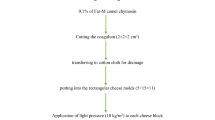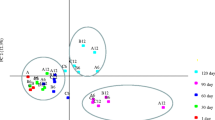Abstract
The effect of rate of addition of starter culture on textural characteristics of buffalo milk Feta type cheese was investigated during ripening period up to two months. The textural characteristics of buffalo milk Feta type cheese in terms of hardness, cohesiveness, springiness, gumminess and chewiness were analyzed by using textural profile analyzer. The maximum hardness was found with cheese made using 1% culture, while the minimum was found with 2% culture. The cohesiveness and springiness decreased as the level of addition of starter culture increased. The chewiness of cheese also decreased, as the rate of addition of starter culture increased for cheese making. In addition to this, yield, moisture, fat, FDM, protein, salt and S/M of fresh buffalo milk Feta type cheese increased with the increase in rate of addition of starter culture; however, TS of experimental cheeses decreased.
Similar content being viewed by others
References
Anifantakis EM (1990). Manufacture of sheep’s milk products. In: Proceedings of the XXIII International Dairy Congress, Vol 1. Mutual Press, Ottawa, p 420–432
Anifantakis EM (1998) Greek cheeses, a tradition of centuries. National Dairy Committee of Greece, Athens
Anonymous (1953) Cheese varieties and descriptions. Agricultural handbook No 54, Laboratory of Eastern Utilization Research and Development Division, Agriculture Research Service, Washington DC, p 4
Chen AH, Larkin JW, Clark CJ, Irwin WE (1979) Textural analysis of cheese. J Dairy Sci 62:901–907
Creamer LK, Olson NF (1982) Rheological evaluation of maturing Cheddar cheese. J Food Sci 47:631–636
Davis JG (1965) Cheese: basic technology, vol 1. J and A Churchill Ltd, London
De Jong L (1976) Protein breakdown in soft cheese and its relation to consistency I. Proteolysis and consistency of Noordhollandse Meshanger cheese. Neth Milk Dairy J 30:242–253
Erdem YK (2005) Effect of ultrafiltration, fat reduction and salting on textural properties of White brined cheese. J Food Eng 71:366–372
Fox PF, Guinee TP, Cogan TM, Mc Sweeney PLH (2000) Fundamentals of cheese science. Cheese rheology and texture. Aspen Publisher Inc, Gaithersburg, pp 298–340
Gilles J (1974). Feta cheese manufactured from skim milk power and anhydrous fat. In Proceedings of the XIX International Dairy Congress (New Delhi). XIX International Dairy Congress Secretariat, New Delhi, India, IE, p 782–783
IDF (1982) Cheese and processed cheese: determination of total solids content (Reference method). IDF standard 4. International Dairy Federation, Brussels
IDF (2008) Bulletin of the International Dairy Federation. The World dairy situation-2008 432: 6
IS:SP-18 (1981) ISI handbooks of food analysis (Dairy Products) (Part XI). Indian Standards Institution, Manak Bhavan
Kandarakis I, Moatsou G, Georgala AIK, Kaminarides S, Anifantakis E (2001) Effect of draining temperature on the biochemical characteristics of Feta cheese. Food Chem 72:369–378
Kosikowski FV (1978) Cheeses and fermented milk foods, 2nd edn. Edwards Brothers Inc., Michigan
Lawrence RC, Creamer LK, Gilles J (1987) Texture development during cheese ripening. J Dairy Sci 70:1748–1760
Manolopoulou E, Sarantinopoulos P, Zoidou E, Aktypis A, Moschopoulou E, Kandarakis G, Anifantakis EM (2003) Evolution of microbial populations during traditional Feta cheese manufacture and ripening. Intl J Food Microbiol 82:153–161
Najafi MN, Koolcheki A, Mahdizadeh M (2008) Studies on the effect of Starter culture concentration and renneting pH on the Iranian brine cheese yield. Am Eurasian J Agric Environ Sci 3:325–332
NDDB (2010) National statistics: production in India http://www.nddb.org/statistics/milkproduction.html. Accessed 17/05/2010
Ozer B, Atasoy F, Akin S (2002) Some properties of Urfa cheese (a traditional white-brined Turkish cheese) produced from bovine and ovine milks. Intl J Dairy Technol 55:94–99
Pappa HC, Anifantakis EM (2001a) Effect of concentrated starter cultures on the manufacture of Feta cheese. Milchwissenschaft 56:325–329
Pappa HC, Anifantakis EM (2001b) Effect of different concentrated cultures on the proteolysis and organoleptic characteristics of Feta cheese. Milchwissenschaft 56:384–387
Pappas CP, Kondyli E, Voutsinas LP, Mallatou H (1996) Effect of starter level, draining time and aging on the physicochemical, organoleptic and rheological properties of Feta cheese. Intl J Dairy Technol 49:73–78
Pyne GT (1932) The determination of milk-proteins by formaldehyde titration. Biochemical J 26:1006–1014
Tamime AY, Kirkegaard J (1991) Manufacture of Feta cheese-Industrial. In: Robinson RK, Tamime AY (eds) Feta and related cheese. Ellis Horwood Limited, Chichester, pp 70–143
Van Slyke LL, Price WV (1952) Cheese, 2nd edn. Orange Judd Pub Corp Inc, New York
Acknowledgement
Authors thankfully acknowledge the Director, National Dairy Research Institute, Karnal for providing the facility for conducting this work. The financial assistance in terms of senior research fellowship (SRF) by ICAR, New Delhi for conducting research work. The first author is also grateful to the authorities of Rajendra Agricultural University, Bihar for grant of study leave.
Author information
Authors and Affiliations
Corresponding author
Rights and permissions
About this article
Cite this article
Kumar, S., Kanawjia, S.K., Kumar, S. et al. Effect of rate of addition of starter culture on textural characteristics of buffalo milk Feta type cheese during ripening. J Food Sci Technol 51, 800–804 (2014). https://doi.org/10.1007/s13197-011-0565-z
Revised:
Accepted:
Published:
Issue Date:
DOI: https://doi.org/10.1007/s13197-011-0565-z




